| Image |
Type |
Built |
Qty |
Used |
Added |
Edited |
|
 |
BR-built Goods Brake Vans |
1949-1961 |
5248 |
1949-current |
15/12/2007 |
03/12/2008 |
|
For many years the goods brake van was a common sight almost everywhere in the UK, bringing up the rear of freight trains. BR built over 5000 vans but the widespread adoption of continuous braking (particularly air brakes) saw their numbers slashed and a mere handful survived into the 21st century.
|
|
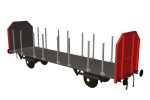 |
OTA Timber Wagons  |
1986-1998 |
c.268 |
1986-current |
23/12/2007 |
23/12/2007 |
|
The OTA type first appeared in 1985 when some surplus air-braked opens were rebuilt into timber carriers following an increase in this traffic. At first using OCA source wagons, the conversions involved the removal of the wagon sides and replacement with tall stanchions, plus the extension of the existing ends. Later rebuilds were from VDAs (retaining the van ends) and OBAs.
|
|
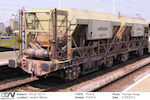 |
Redland Self-Discharge Trains  |
1988-1990 |
124 |
1988-current |
01/01/2008 |
17/05/2008 |
|
The Self-Discharge Trains operated by Redland (later Lafarge) were an attempt to combine the rapid unloading characteristics of hopper wagons with the operational flexibility of open wagons that required no specialised unloading equipment. This is achieved by use of a conveyor built into the bottom of each set of wagons and an unloading vehicle coupled at one end. Despite the mechanical complexity of the concept it appears to have been successful with several sets built for use both in the UK and abroad.
|
|
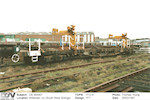 |
YAO 'Dolphin' and YBO 'Sturgeon' Bogie Rail, Sleeper and Ballast Wagons  |
1950-1961 |
973 |
1950-2004 |
01/01/2008 |
10/04/2008 |
|
The Dolphin and Sturgeon wagons were based on an LNER design and were adaptable bogie rail, sleeper and ballast carriers. Small wheeled bogies and low floors made them useful at worksites and they featured dropside doors that could be removed to allow the carriage of rails and track panels. The 40t Dolphins were all withdrawn by 1993 but many of the Sturgeons were fitted with air brakes and a few survived into the 21st century.
|
|
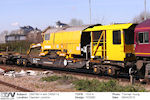 |
YEA Perch/Porpoise LWRT Trains |
1982-1985 |
192 |
1982-current |
01/12/2006 |
13/04/2010 |
|
When your cargo is 600ft long, you need a special type of wagon. The YEA wagons were part of an ingenious system designed to handle lengths of continuously welded rail, with the ability to unload single rails at work sites. The sets include components classified as on-track plant and the concept was obviously sound as new wagons built from 2002 shared the same configuration.
|
|
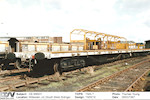 |
YMO 'Salmon' Bogie Rail Wagons  |
1949-1983 |
895 |
1949-current |
01/01/2008 |
16/03/2010 |
|
The Salmon was a bogie rail wagon built in large numbers during BR's early years. Surprisingly, almost 400 remained in stock in 2008, most having been upgraded with air brakes and new bogies. The type is now mainly used for carrying track panels.
|
|











